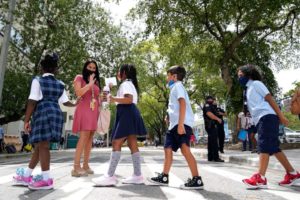
As many children and teens return to a new school year after Labor Day, educators and advocates are alarmed on the challenges that Black and Latino students face.
According to a Department of Education’s report released this summer, Black and Latino students were left behind during the pandemic, which worsened disparities in access and opportunities for students of color in public schools. The pandemic turned the world upside down in 2020, educators, students, and administrators had to adapt to a changing world. Some students began virtual schooling, which highlighted gaps in internet and technology access.
According to the 2020 Census data, 1 in 10 Black and Latinx homes lacked consistent computer access, compared to only 6.7% of white households, meaning children had a harder time accessing online classroom materials, homework or virtual classes themselves. For other students, schooling wasn’t the only obstacle amid the COVID-19 pandemic, the virus hit close to home.
Many students were faced with sick or dying family members, friends, and neighbors. According to the CDC, Latinos are about two times more likely to catch the virus. Black children made up 20% of those who lost a parent to COVID-19 despite only making up 14% of all children in the U.S.
The pandemic also caused social isolation which forced many people to face new mental health struggles. “This has been such a disruptive event that has touched a lot of families personally, and children, they take all of this in. It’s going to be important for school systems to provide wraparound supports to not only help students get back on track with unfinished learning but also to provide assistance and support along the way,” said Amalia Chamorro, the Director of the Education Policy Project at UnidosUS.
Education advocates are hoping for teachers and school administrators to turn these statistics into learning opportunities and support students of color. Also, culturally competent outreach services, tutoring and counseling can help turn the tide on disparities in education as well as incorporating Spanish-language resources to Latino families so they can address needs at home and help students outside of the walls of school can make a big difference.
Marc Morial, President and CEO of the civil rights group National Urban League said, “People have to understand the interdependency of the issue, and the necessity of ensuring that we close these resource gaps in education. These young people have borne the most difficult brunt of the pandemic and must be given extra support. And I think the smart thing to do is to say to teachers: ‘What do you need? We have resources, how should we deploy them?'”.

Recent Comments